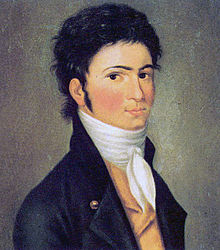
Beethoven
The year 1802 was a year of despair for Beethoven. His hearing had been declining since 1796 and he had been consulting doctors everywhere. Finally, in mid-1801 he found Professor Johann Schmidt, who became his personal physician until his death in 1809.
Schmidt got Beethoven to leave Vienna and go to the countryside. He needed to calm his nerves, get out of city life and care for his hearing. Beethoven decamped to the village of Heiligenstadt and lived there from April to October. Unfortunately, during this 6-month vacation, Beethoven’s health didn’t change, and, at the same time, he feared it would never improve. For a composer of his stature and creativity, deafness was the worst insult life could deal him.
On 6 and 10 October 1802, in the depths of his despair, he wrote out his thoughts. This document, now known as the Heiligenstadt Testament, was addressed to his brothers and to the public. Its words make it seem that Beethoven was considering suicide. In the document, he blames his incompetent doctors for deceiving him on the real nature and curability of his deafness. His life of isolation was a torment to him as was the constant reminder of his handicap. However, ‘…I would have put an end to my life – it is only my art that held me back. Ah! It seemed impossible to me to leave the world before bringing forth all I felt in me, and so have I endured this miserable life.’ He would meet death with joy because it would alleviate his endless suffering.

Anton Schindler
We know he didn’t commit suicide but refocused himself on his art. 1802, in fact, was one of his most prolific years. The hiatus might not have improved his health, but it did give him the opportunity to sit down and write. He worked on the piano genres of the sonata and the variation, creating the Bagatelles, Op. 33, and the Op. 34 and 35 Variations. He composed the three Op. 30 violin sonatas, the three Op. 31 piano sonatas, and wrote his Symphony No. 2, Op. 36.
When we look at the music and focus on the Piano Sonata No. 17 in D minor, op. 31/2, Tempest, we find a work that reflects Beethoven’s 1802 feelings. Its title, Der Sturm (The Tempest), comes not from Beethoven but from a comment he made to Anton Schindler. Schindler asked Beethoven how to interpret this work and Beethoven told him he should read Shakespeare’s Tempest, and so the work received its nickname, although Beethoven never used it.
The first movement, indeed, launches us off into alternations of peacefulness with stormy sections. Eventually, the storm defeats the peace, and, for a pianist, the movement is ideal for showing the changes in technique and tempo needed between the sections.
Ludwig van Beethoven: Piano Sonata No. 17 in D Minor, Op. 31, No. 2, “Tempest” – I. Largo – Allegro (Jonas Vitaud, piano)

Ivan Aivazovsky: The Tempest © Wiki Art
The second movement Adagio is in sonata form, although its development section is quite abbreviated. What Beethoven does in this movement, however, is to contrast the upper and lower registers of the piano, which at his time, were different sounds. The fortepiano of Beethoven’s time had different tone qualities in the high register (tinkly), the low register (buzzy) and a more rounded middle register that’s not unlike the modern piano’s more uniform sound. Beethoven’s own playing was praised for his ‘singing tone’ on the piano and a movement like this would permit him to show that off.
Ludwig van Beethoven: Piano Sonata No. 17 in D Minor, Op. 31, No. 2, “Tempest” – II. Adagio (Jonas Vitaud, piano)
The final movement is the bravura show-off movement. It’s energetic, flowing, and, yet, because of the D minor key, somewhat bitter. If the middle movement was a contemplative pause, this movement becomes the unhappiness of the ailing genius. The development section focuses on the opening figure of the movement and has the effect of concentrating the whole work down to just a single figure, something that he would perfect in Symphony No. 5.
Ludwig van Beethoven: Piano Sonata No. 17 in D Minor, Op. 31, No. 2, “Tempest” – III. Allegretto (Jonas Vitaud, piano)
Beethoven, caught between his deafness and his creativity, decided to let his art, not his illness run his life. His greatest works were still ahead of him in 1802 and, although the Heiligenstadt Testament shows us the depths of his despair, the works he created show how he used his talents to draw himself back into the world.
For more of the best in classical music, sign up to our E-Newsletter


